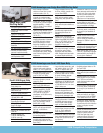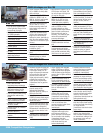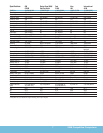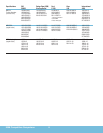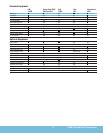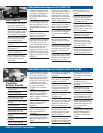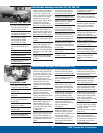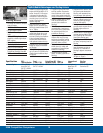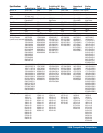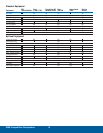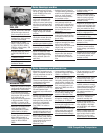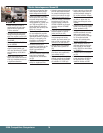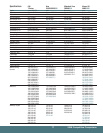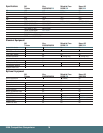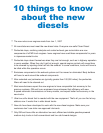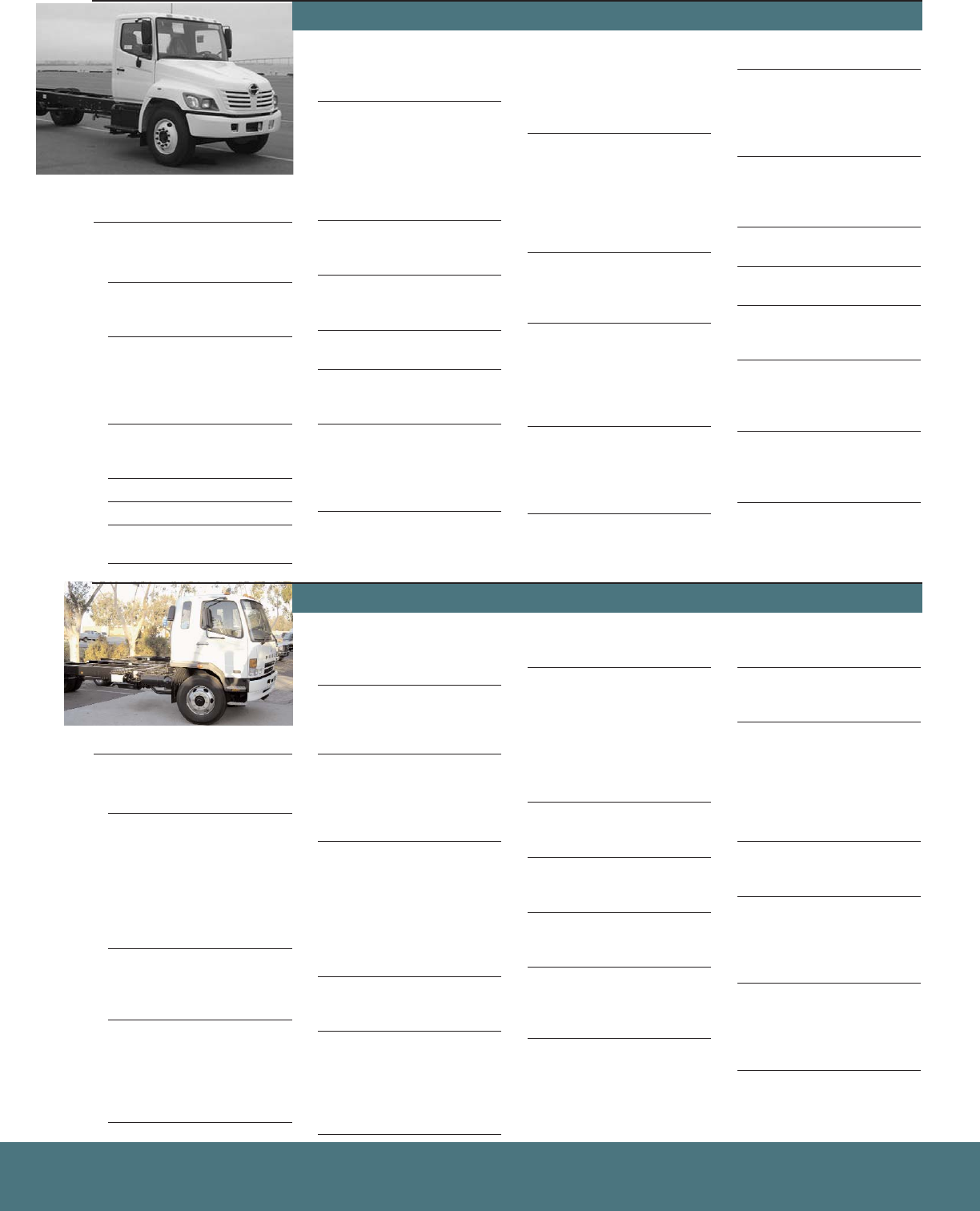
15 2008 Competitive Comparison
Hino 238, 258LP, 268,
268A, 338
» The 238, 258LP, 268, 268A and
338 are the larger versions of
Hino’s conventional cab trucks
» The conventional cab was
developed from Hino’s previous
Low Cab Forward design
» 238 is 23,000 lb. GVWR;
258LP is a low-profile 25,500
lb.; 268 is 25,950 lb.;268A is
25,950 lb. with air brakes; 338
is 33,000 lb. GVWR
» 6-cylinder diesel only, 220 hp
on 238, 258, 268; 260 hp on
338
» 7 wheelbase choices
» Limited options
» Hino setting up urban-based
distribution network
• Power options from 215 hp to
300 hp vs. single engine choice
at each GVWR for Hino and a
maximum of 260 hp
• Large cowl-mounted folding
mirrors with integrated wide-
angle mirror and numerous
options for power, heat and sig-
nals (Hino has traditional West
Coast mirrors with add-on spot
mirrors)
• Available driver and front pas-
senger air bags (not available
on Hino)
• 3-point cab mount with avail-
able Hystec mounts (Hino has
no Hystec mounts available)
• Available two-speed rear axle
available (not available on Hino)
• Extensive Chevrolet and GMC
dealership body vs. limited
urban retailers for Hino
• Choice of vocationally rated
Allison automatics to match
engine output (single 5-speed
Allison automatic option for
each Hino)
• Available 6-speed, 9-speed or
10-speed manual transmissions
suited for many different appli-
cations vs. single 6-speed
direct drive manual transmis-
sion available on Hino
• Available air seats for driver and
front passenger add all-day
comfort, plus work-center con-
sole provides vocational utility
(Hino has standard driver air
seat and fixed two-person
bench seat)
• Available electronic traction
control helps improve traction
on slippery surfaces (not avail-
able on Hino)
• Extensive choices for frame
length and strength (Hino has a
total of seven wheelbase
options, but not all on the same
weight trucks, and no frame
strength options)
• Short wheelbase T-Series
tractors offer high maneuver-
ability and cab comfort. No
short WB tractor available on
Hino
• Available tandem axle (not
available on Hino)
• Choice of axle ratios allows
customer to match product to
needs for towing or geared
road speed (two ratios only
available on Hino)
• Progressive spring aids help
cushion load and chassis from
impacts when suspension bot-
toms (not available on Hino)
• RediSpec or custom spec avail-
ability vs. single spec Hino
• Available taperleaf rear springs
(not available on Hino)
• High capacity dual 750 CCA
batteries, vs. dual 600 CCA
standard on Hino
• Standard automatic engine
shutdown prevents possible
engine damage (not available
on Hino)
• Available aluminum hub-piloted
wheels reduce vehicle weight,
for increased payload (not
available on Hino)
T-Series Advantages over Hino
Mitsubishi Fuso
» Mitsubishi Fuso sells a lineup of
weight-specific tilt-cab trucks that
sell against the T-Series trucks
» All of these Mitsubishi Fuso
trucks use the same Mitsubishi
diesel engine. 243 hp and 514
lb.-ft. torque with the
Mitsubishi manual transmission
or Allison automatic. 274 hp
and 593 lb.-ft. torque on FM
with Eaton manual transmission
» Mitsubishi Fuso model nomen-
clature identifies GVWR.
The FM260 GVWR is 25,995;
FM330 GVWR is 32,900 lb.
» Transmission choices limited to
6-speed direct drive manual or
Allison 2400 automatic on
FM260 or 6-speed or 9-speed
manual or Allison 3060 on
FM330
» Mitsubishi Fuso trucks are not
spec’d, but selected from stock,
with only wheelbase choices as
a significant alternative
• Spec-based configuration allows
T-Series to meet customer needs
(model-based configuration
with Mitsubishi Fuso)
• Choice of taperleaf or multileaf
front suspension to handle high
CG loads (taperleaf front
suspension only on Mitsubishi
Fuso)
• Hydraulic opposed-piston front
and rear disc brakes standard
below 33,000 lb., for powerful
braking and easy service (front
and rear air-over-hydraulic
drum brakes on Mitsubishi
Fuso FM260. Air brakes on
FM330)
• Resin plate protectors for door
handles help protect cab (not
available on Mitsubishi Fuso)
• Back-of-cab reservoir access
for oil, coolant, power steering
and brake fluid simplifies daily
service (back-of-cab reservoir
access for oil only on
Mitsubishi Fuso)
• Longer maximum wheelbase
can handle longer body lengths
(260.0 in. vs. 239.4 in.)
• Choice of taperleaf, multileaf or
air rear suspension provides
ride quality, durability and light-
weight benefits (multileaf rear
suspension only on Mitsubishi
Fuso, except optional air sus-
pension on FM260 with 218 or
239-in. WB)
• Optional bolted-on rear suspen-
sion for ease of adapting (not
available on Mitsubishi Fuso)
• Higher maximum frame yield
strength for durability (120,000
psi available vs. 51,200 psi)
• Low Profile Package optional
for lower ride height (not avail-
able on Mitsubishi Fuso)
• Longer warranty on frame rails
helps control repair costs (60
months/unlimited mileage vs.
48 months/unlimited mileage)
• Tilt-cab mechanism in a safer
location (passenger side vs.
driver side)
• Lower passenger-side window
enhances driver vision (not
available on Mitsubishi Fuso)
• Longer, more comprehensive
roadside assistance coverage
helps reduce service costs (36
months/unlimited mileage vs.
24 months/unlimited mileage;
full roadside assistance vs.
towing only)
• Unlimited mileage powertrain
warranty vs. 250,000-mile
powertrain warranty limit
• Higher available GVWR, for
maximum load carrying capa-
bility (40,090 lb. with single
axle or 56,000 lb. with tandem
vs. 32,900 lb.)
• Choice of engine power from
200 hp to 300 hp allows cus-
tomer to tailor truck to needs.
Mitsubishi Fuso has single
engine output for each model
T-Series Advantages over Mitsubishi Fuso



